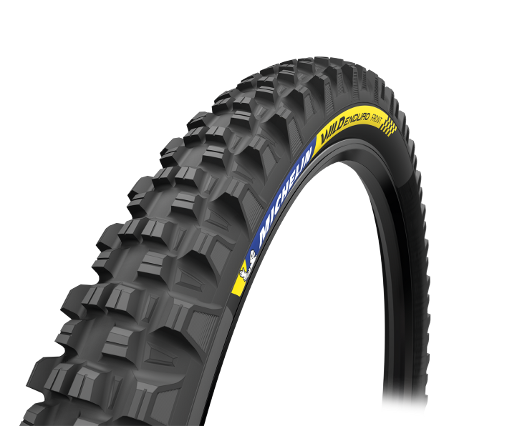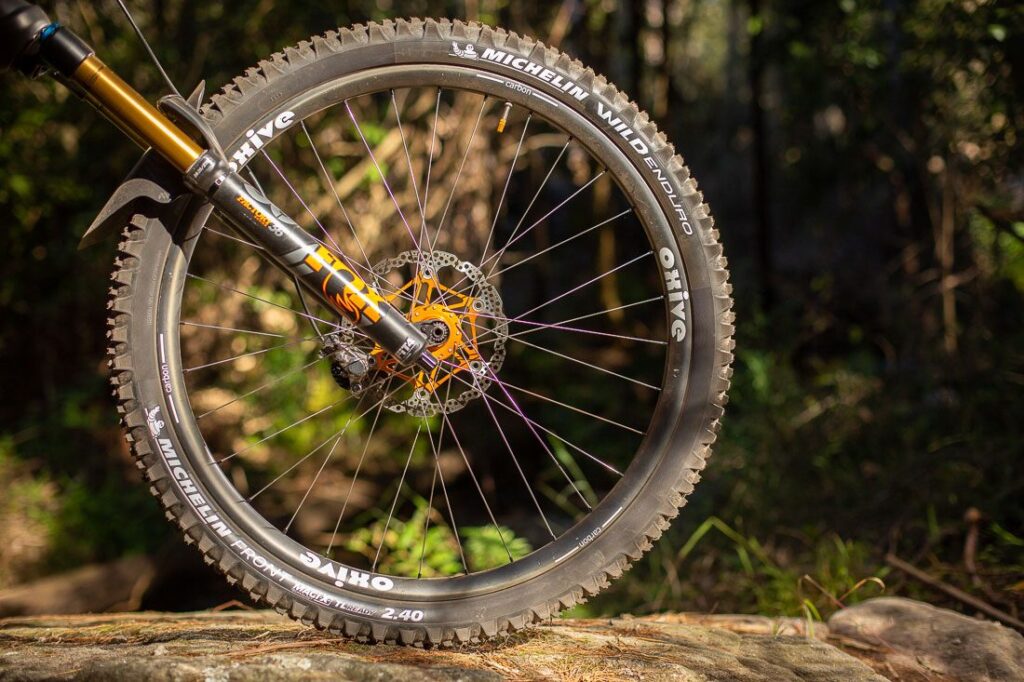Introducing the Michelin Wild Enduro
The Michelin Wild Enduro, both front and rear, are 2.4 at both ends. I’ve been riding with these for a while now, and the standout feature has to be the unique combination of compounds used. The front is designed with the Magix compound, while the rear employs the Gum X. Although the Gum X is a tad softer, the Magix is recommended for its superior performance at higher speeds. Surprisingly, despite its reputation, the Magix feels slightly harder. When you interact with the knobs, their firmness is evident.
This results in a slightly choppy ride, especially on uneven terrains.
Riding in Adelaide: A Test for Any Tire
Currently, Adelaide’s trails, where I’ve tested these tires extensively, are dry and hard, even though we’re in the throes of winter. It’s under these conditions that the Michelin Wild Enduro truly demonstrates its prowess. Especially on off-camber, slick, and hard pack terrains, these tires exhibit exceptional grip. The knobs bite into the ground with an unparalleled tenacity, ensuring maximum traction.
Performance on Various Terrains
However, there’s a caveat. While the Wild Enduro shines on wet, slippery terrains, it’s a different story as things dry up. On steeper trails, characterized by loose gravel overlaying hard packs, the tires demand caution during braking and directional changes. Their hard composition means you need to be gentler and less aggressive, as they don’t offer the same instantaneous grip on such terrains.
On Speed and Agility
Coming to the rear tire, it sports a somewhat lower profile. Contrary to popular belief, I found that it doesn’t compromise on speed. In fact, many might argue it rolls slowly, but my experience suggests otherwise. The Wild Enduro feels lively and responsive. Their agility on trails is commendable, making them easy to pedal and ensuring they don’t lag. This vivacity is a definite plus, as it ensures riders can maintain momentum without extra effort.
Understanding the Michelin Wild Enduro’s Composition
The Michelin Wild Enduro, a popular choice among mountain bike enthusiasts, often draws attention for its unique composition. The question on many riders’ minds, “Is the Michelin Wild Enduro soft?”, deserves a detailed exploration.
Front vs. Rear: A Tale of Two Tires
While the rear of the Michelin Wild Enduro feels acceptable to me, the front leaves something to be desired. To be honest, I’m not quite fond of the sensation it offers. Comparatively, the back tire feels softer, albeit with a hint of choppiness. However, when closely examined, one can notice that the knobs are slightly gooier and more compliant. Despite this, it doesn’t entirely align with my preferences. In terms of raw performance, I’ve always had a slight leaning towards the “aggressor” for the rear. But, credit where it’s due, the Michelin Wild Enduro does provide superior cornering grip. On softer terrains, the tire exhibits exceptional traction that can only be described as sublime.
Seasonal Considerations and Overall Feel
Given their specific texture and grip, I’m skeptical about using these tires during the summer. Their unique composition, while excellent for some terrains, took me a while to adjust to. Initially, I found myself hesitating, especially when it came to trusting the front tire’s grip. As I continued to test them on various trails and terrains, my confidence grew. Still, they aren’t quite the perfect fit for me. One major drawback I noticed is the pronounced choppiness. Instead of a smooth ride, the tires make even mild terrains feel excessively bumpy, akin to riding on a fork that’s either over-damped or over-sprung, even when maintaining consistent pressure and settings.
Michelin Wild Enduro vs. DHF Max Grip: The Showdown
Choosing the right tire for your mountain bike can often come down to personal preferences and the specific terrains you traverse. While I consistently refer to the DHF Max Grip as my go-to, how does it fare against the Michelin Wild Enduro?
The Stellar Performer: DHF Max Grip
For me, the DHF Max Grip stands out in numerous conditions. It might roll slightly slower than the Max Terra, but its super compliant nature combined with impressive grip makes it a front runner. The DHF shines in almost all terrains, save for those exceptionally slick, sun-deprived, wintry hard packs. In these rare conditions, the tire requires a more assertive handling approach. Contrarily, the Michelin Wild Enduro outperforms the DHF in such environments.
Considering Local Conditions: The Adelaide Experience
However, in Adelaide, the situation varies. The terrains here rarely mimic the slick conditions where Michelin Wild Enduro takes the lead. In a year, I might encounter only two or three such rides. Adelaide’s terrains generally oscillate between hard packs and loose, dusty trails. Given these conditions, the Michelin Wild Enduro tires aren’t my first choice. I crave a more supple front tire, one that dampens the noise and offers enhanced grip, particularly when braking hard on loose and steep grounds. In such scenarios, the Michelin Wild Enduro tires don’t quite measure up to the DHF Max Grip, or perhaps even to the performance of a Nasa Guy.
Assessing the Rear Performance
When it comes to the rear tire, opinions seem to be polarized. Some individuals believe it doesn’t hold up well, while others praise it.
Personally, I find the rear Michelin Wild Enduro tire’s performance satisfactory. Today, as I head out for runs at Horsenall’s Galley, I contemplate reverting to a DHF tire primarily due to the expected loose terrain. The familiar, reliable feel of the DHF just resonates better with me. Nevertheless, I might retain the Michelin Wild Enduro’s rear tire for now, weighing its pros and cons. But, in terms of weight, it’s worth noting that it’s not the lightest option available. The front tire is approximately a kilo, leaning towards 1040 grams, to be precise.
The Trail Tire Dilemma: Weighing the Choices
Choosing the perfect trail tire is an art, taking into account a multitude of factors from terrain to personal riding style. In my quest to find the best, I’ve experimented with a variety of options, each presenting their own sets of advantages and drawbacks.
On Equal Grounds: Comparing Weights
At a first glance, both the tires in question seem to be on a similar footing, especially when it comes to weight. They’re both designed as trail tires, and on the scale, they don’t show significant disparities. However, weight is just one part of the equation when evaluating the overall performance of a tire.
The Right Terrain for the Tire
Every tire thrives in its own unique environment. In conditions that are wet or where the dirt is soft enough for the tire to penetrate, these trail tires are undoubtedly top-notch. They grip and navigate with a finesse that can only be described as ‘killer’. Yet, the story alters when the terrain does. In areas characterized by dry and hard-packed conditions, their efficiency takes a dip.
From my perspective and experiences, they may not be the best choice for such terrains.
My Tried and Tested Combo
Over the years, I’ve found solace in a particular combination that seems to resonate with my riding style and the terrains I frequently explore. The Aggressor rear with a double down and the DHF Max Grip upfront have rarely disappointed. Recently, I also gave the Magic Mary a shot and the initial rides felt promising. It presented nuances that were somewhat reminiscent of the trail tire in question, especially the front one.
Conclusion
Choosing a tire goes beyond just the brand or the specifications; it’s about the synergy between the rider, the bike, and the terrains encountered. While the trail tires I discussed are undeniably great, they might not be the exceptional choice for every rider or every condition. Everyone’s riding journey is unique, and what works for one might not necessarily be the magic formula for another. It’s essential to evaluate tires not just by their standalone virtues, but how they align with individual preferences, riding conditions, and specific needs. For now, while I appreciate the merits of these trail tires, I remain steadfast in my belief that the combination of Aggressor rear and DHF Max Grip upfront best complements my riding adventures.





